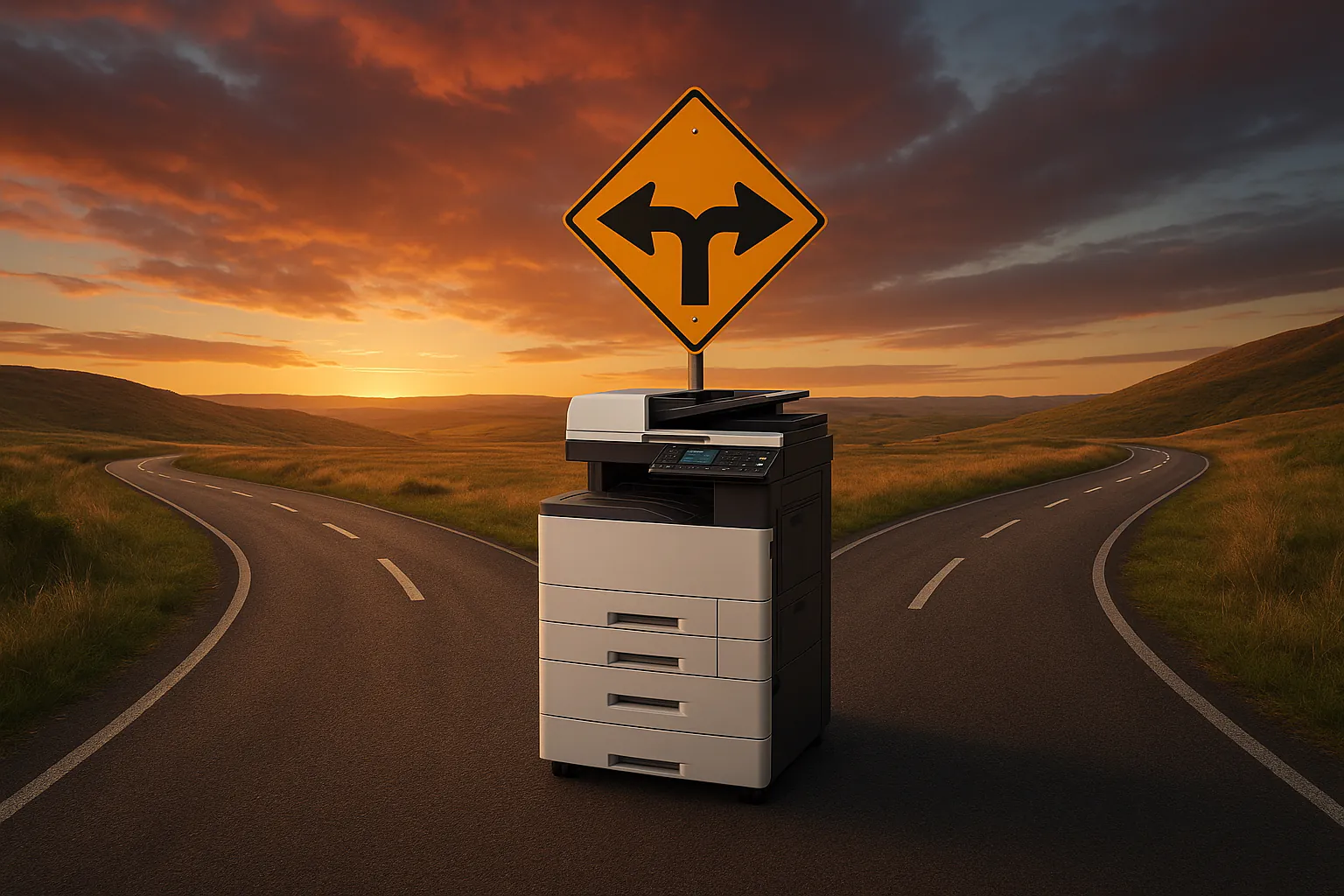What We Cover in This Guide
- How copier, printer, and MFP leasing works in practice.
- The differences between FMV, $1 buyout, step, and deferred leases.
- What a rate factor is (and how it’s different from an interest rate).
- The most common lease terms — 24, 36, 48, 60, and 72 months, plus special cases like 63 months.
- The potential tax considerations, property tax, and insurance requirements.
- Practical tips for returns, pick-ups, and hidden costs to clarify with your vendor.
Leasing in plain English
Leasing is “rent with options.” Instead of dropping $8,000–$12,000 upfront on a Toshiba A3 copier or a Kyocera A4 device, you spread the cost into predictable payments.
At the end, you decide: keep it, upgrade it, or buy it.
And the biggest advantage? You’re not stuck with surprise repair bills or scrambling when a device ages out.
Doceo Tip: Don’t just compare the monthly payment number. Look at what’s included. Bundling toner, service, and print management software like PaperCut into your lease can save time and hassle.
Lease types explained
| Lease Type | Monthly Payment | End-of-Term Options | Best For |
|---|---|---|---|
| FMV (Fair Market Value) | Lowest | Return, renew, or buy at fair market value | Teams that want flexibility and upgrades |
| $1 Buyout | Higher | Own the device for $1 | Buyers who want long-term ownership |
| Step Lease | Starts low | Increases over time | Businesses growing into new capacity |
| Deferred Lease | Skips first 60–90 days | Begin payments later | Firms waiting on budget cycles |
Mini-scenario:
A regional accounting firm signs a deferred FMV lease in June for new A4 MFPs. Their payments don’t kick in until September — just in time for their fiscal year. That breathing room makes it an easy “yes.”
What’s a rate factor again?
Here’s the quick guide:
- Rate Factor = a decimal you multiply by the equipment cost to get your monthly payment.
- Interest Rate = the lender’s actual return, hidden behind the math (rarely shown in copier leasing).
Example: $15,000 device × 0.026 = $390/month.
So when your lease provider mentions a “.026 rate factor,” they’re handing you the shortcut.
Doceo Tip: If you’re curious about the true interest rate, ask. A Doceo Print Technology Advisor will show you how it pencils out over the lease term.
Lease term length: the common options
Most copier and MFP leases fall into these buckets:
- 24 months — higher payments, faster refresh.
- 36 months — popular balance of predictability and flexibility.
- 48 months — stretches refresh cycle a bit longer with a mid-range payment.
- 60 months — lowest standard monthly payment, but longer commitment.
- 72 months — rare, but offered. Lowest possible monthly cost, but your team may outgrow the device.
And sometimes, a leasing company will offer a 63-month term to align with fiscal calendars or specific business goals.
Doceo Tip: Treat the term length as a planning tool. The right choice balances predictable payments with the expected duty cycle of the device .
Lease vs. Buy: A Simple Snapshot
| Factor | Lease (FMV or $1 Buyout) | Buy (Outright Purchase) |
|---|---|---|
| Upfront Cost | Minimal (first payment + fees) | Full purchase price on Day 1 |
| Monthly Payments | Predictable (24–72 months) | None |
| Ownership | FMV: option to return, extend, or buy at FMV. $1 buyout: own for $1 at end. | You own it immediately |
| Refresh Cycle | Easier to upgrade at end (or mid-term) | Refresh requires new purchase |
| Service & Supplies | Often bundled (MPS agreement) | Separate contracts or ad hoc service |
| Tax Treatment | FMV: often deductible as expense. $1 buyout: often depreciated as asset. | Typically depreciated as asset |
| Best Fit | Firms wanting predictability, flexible refresh, preserved cash flow | Firms wanting long-term use and control |
Doceo Tip: Leasing doesn’t eliminate cost — it changes when and how you pay. The right choice depends on whether you value predictability and flexibility, or full control and long-term ownership.
What’s a buyout?
A buyout is the option you exercise at the end of your lease. It’s the decision point: keep, return, or move on.
Types of buyouts include:
- Fair Market Value (FMV) Buyout — Pay the device’s current market value, return it, or upgrade into new equipment. Lowest monthly payments, most flexibility.
- $1 Buyout — Lease-to-own. Higher payments, but you own the device at the end for $1.
- Buyout to Keep — Exercise the purchase option (FMV or $1). Ownership transfers to you, and service agreements may continue separately.
- Buyout to Return — Hand the device back. Useful if you no longer need the equipment or want to refresh.
- Buyout to Upgrade — Return or trade in the device and roll into a new lease with updated hardware. Common when teams outgrow their device mid-term.
Doceo Tip: Buyouts come with different costs and logistics. Always clarify how pick-ups, shipping, or returns are handled, and lock those details into your agreement. That way, you’re not surprised by additional charges at lease end.
Hidden costs and responsibilities to check
Leases can be straightforward — but there are a few line items to confirm early:
- Property Tax: In some regions, leased equipment is subject to property tax. This may come as a separate bill from the leasing company.
- Insurance Coverage: Most lease agreements require you to maintain insurance on the asset. Often your existing business insurance policy can cover this — confirm with your provider.
- Pick-Up & Return Fees: If you choose a return buyout, check whether there are costs for packaging, freight, or pick-up. Some vendors include this, others bill it separately.
- End-of-Lease Notices: Many leases auto-renew if you don’t provide written notice by a set deadline. Put reminders on your calendar.
Doceo Tip: Treat the lease agreement like a playbook. Ask for the “end-of-term” section in plain English before signing — and confirm any extra costs tied to property tax, insurance, or returns.
Tax considerations: operating vs. capital leases
Leasing isn’t just about spreading payments — it can also affect how costs are treated at tax time. In general:
- FMV lease (operating lease): Often treated as a business expense, with the full payment deductible each month or year.
- $1 buyout lease (capital lease): Often treated more like ownership, with depreciation of the equipment as an asset.
Doceo Tip: Leasing strategy should consider more than just cash flow — accounting treatment matters too. But tax rules change. Always consult your licensed tax consultant for the latest guidance on how a lease applies to your business.
ROI and impact: let’s do the math
Scenario:
You’re evaluating a Xerox production printer priced at $25,000.
- Term: 63 months (special option)
- Rate factor: 0.021
Formula:
$25,000 × 0.021 = $525/month
Instead of tying up $25,000 in one lump sum, you preserve that capital for hiring, marketing, or expansion — while still getting professional-grade output.
Before you sign a copier lease: 5 things to confirm
- Lease Type — FMV, $1 buyout, step, or deferred. Which fits your strategy?
- Term Length — 24, 36, 48, 60, 72 (and occasionally 63). Does it align with device life?
- Rate Factor — Know the multiplier and monthly payment. Ask how it maps to an effective interest rate.
- What’s Included — Is toner, service, and PaperCut reporting part of the deal, or separate?
- End-of-Term Options — Upgrade, extend, or purchase at FMV? Confirm pick-up, shipping, and any fees in advance.
Doceo Tip: Walk into the leasing conversation with this checklist. It signals you’ve done your homework and keeps the process transparent.
FAQs
Q: What lease terms are available?
Most copier leases are structured around 24, 36, 48, 60, or 72 months, depending on budget and refresh strategy. Sometimes, finance providers create a custom term — like 63 months — to match a fiscal cycle or business goal.
Q: Is leasing better than buying?
Depends. Leasing offers predictability and refresh flexibility. Buying may save over the long haul if you plan to run devices far past their expected life .
Q: What happens if I outgrow my device mid-term?
Many leases allow upgrades or additions, though terms vary. A Doceo Print Technology Advisor can map right-sizing options .
Q: Can service and toner be wrapped into the lease?
Yes. That’s the managed print services (MPS) model — one payment covers hardware, toner, service, and reporting .
Q: Are there extra costs at lease end?
Possibly. Property tax, insurance, or return shipping may apply. Always confirm these items with your provider upfront.
Closing thought
Leasing a copier, MFP, or printer isn’t just about payments. It’s about cost predictability, refresh cycles, and peace of mind that your team won’t grind to a halt when devices age out.
Next Step
If you’re weighing a copier, printer, or MFP lease, the cleanest move is to talk it through with someone who does this every day. A Doceo Print Technology Advisor can walk you through the options — FMV, $1 buyout, term length, bundled service — and share what’s worked for businesses like yours in the Mid-Atlantic region.
👉 Request a free consultation with a Doceo Print Technology Advisor
No pressure — just clear answers and practical options.


